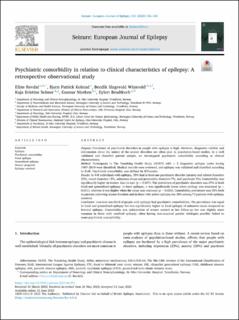| dc.contributor.author | Revdal, Eline | |
| dc.contributor.author | Kolstad, Bjørn Patrick | |
| dc.contributor.author | Winsvold, Bendik Kristoffer Slagsvold | |
| dc.contributor.author | Selmer, Kaja Kristine | |
| dc.contributor.author | Morken, Gunnar | |
| dc.contributor.author | Brodtkorb, Eylert | |
| dc.date.accessioned | 2023-12-18T10:21:07Z | |
| dc.date.available | 2023-12-18T10:21:07Z | |
| dc.date.created | 2023-08-23T11:07:09Z | |
| dc.date.issued | 2023 | |
| dc.identifier.issn | 1059-1311 | |
| dc.identifier.uri | https://hdl.handle.net/11250/3107991 | |
| dc.description.abstract | Purpose
Prevalence of psychiatric disorders in people with epilepsy is high. However, diagnostic validity and information about the nature of the seizure disorders are often poor in population-based studies. In a well validated and classified patient sample, we investigated psychiatric comorbidity according to clinical characteristics.
Method
Participants in The Trøndelag Health Study (HUNT) with ≥ 2 diagnostic epilepsy codes during 1987–2019 were identified. Medical records were reviewed, and epilepsy was validated and classified according to ILAE. Psychiatric comorbidity was defined by ICD-codes.
Results
In 448 individuals with epilepsy, 35% had at least one psychiatric disorder (anxiety and related disorders 23%, mood disorders 15%, substance abuse and personality disorders 7%, and psychosis 3%). Comorbidity was significantly higher in women than in men (p = 0.007). The prevalence of psychiatric disorders was 37% in both focal and generalized epilepsy. In focal epilepsy, it was significantly lower when etiology was structural (p = 0.011), whereas it was higher when the cause was unknown (p = 0.024). Comorbidity prevalence was 35% both in patients achieving seizure freedom and in those with active epilepsy but 38% among 73 patients with epilepsy resolved.
Conclusion
Just over one third of people with epilepsy had psychiatric comorbidities. The prevalence was equal in focal and generalized epilepsy but was significantly higher in focal epilepsy of unknown cause compared to lesional epilepsy. Comorbidity was independent of seizure control at last follow-up but was slightly more common in those with resolved epilepsy, often having non-acquired genetic etiologies possibly linked to neuropsychiatric susceptibility. | en_US |
| dc.language.iso | eng | en_US |
| dc.publisher | Elsevier B. V. | en_US |
| dc.rights | Navngivelse 4.0 Internasjonal | * |
| dc.rights.uri | http://creativecommons.org/licenses/by/4.0/deed.no | * |
| dc.title | Psychiatric comorbidity in relation to clinical characteristics of epilepsy: A retrospective observational study | en_US |
| dc.title.alternative | Psychiatric comorbidity in relation to clinical characteristics of epilepsy: A retrospective observational study | en_US |
| dc.type | Peer reviewed | en_US |
| dc.type | Journal article | en_US |
| dc.description.version | publishedVersion | en_US |
| dc.source.pagenumber | 136-143 | en_US |
| dc.source.volume | 110 | en_US |
| dc.source.journal | Seizure | en_US |
| dc.identifier.doi | 10.1016/j.seizure.2023.06.011 | |
| dc.identifier.cristin | 2168961 | |
| cristin.ispublished | true | |
| cristin.fulltext | original | |
| cristin.qualitycode | 1 | |

